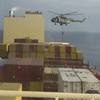NOAA and the U.S. Navy have succeeded in raising the world's first armored revolving gun turret from the wreck of the famous Civil War ironclad USS Monitor, which rests below 240 ft. of water 16 miles southeast of Cape Hatteras, N.C., in the "Graveyard of the Atlantic." Also recovered were the vessel's two large Dahlgren cannons. Yesterday's retrieval of the turret and cannons marks the end of a multi-year effort by NOAA, the Navy and The Mariners' Museum to preserve key components of the revolutionary ship before sea water corrodes the vessel beyond recognition. The turret, with the cannons inside, was hoisted from the sea floor by a 500-ton crane aboard the Derrick Barge Wotan, owned and operated by Manson Gulf Industries. The turret was then secured on the barge's deck for transport to The Mariners' Museum in Newport News, Va., where conservators will begin the 10-year process to preserve it. "The successful recovery of the Monitor's famous gun turret is the culmination of a NOAA long-range management plan submitted to Congress in 1998," said John Broadwater, manager of NOAA's Monitor National Marine Sanctuary and chief scientist of Monitor Expedition 2002. "The turret will remind present and future generations of the Monitor's story and of the men and women from NOAA and the Navy who rescued the Monitor after 140 years."
"Future generations will not have to rely on paintings and faded photographs to remember the Monitor," said Broadwater. "Her story will now be told through the very icon that made her famous-the world's first armored revolving gun turret."
Prior to the lift, NOAA and Navy teams worked for six weeks to remove a 30-ton section of the Monitor's hull plating and armor belt to uncover the turret and its contents, including the ship's two 11-inch smoothbore Dahlgren cannons.
"This is truly a historic day," said Commander Bobbie Scholley, commanding officer, Mobile Diving and Salvage Unit Two and officer in tactical command of Monitor Expedition 2002. "The men and women that make up this wonderful Monitor team have displayed incredible hard work and dedication over the last six weeks to bring us to this point. I am so proud to have been a part of this team that has made it possible to bring back this important part of our heritage so that it can be preserved and enjoyed by generations to come." The multi-disciplinary effort is a joint effort between NOAA, the Naval Sea Systems Command (NAVSEA), Mobile Diving and Salvage Unit Two (MDSU TWO) and The Mariners' Museum.
More than 200 artifacts have been recovered during the 41-day expedition, including a glass button, hydrometers, working thermometers, an intact lantern chimney and two stanchions. All have been conveyed to The Mariners' Museum for conservation and exhibit. Possible human remains also were recovered from the turret and transported to the U.S. Army's Central Identification Laboratory in Hawaii for analysis and identification.
Located in a historically rich area of the United States, the world-famous Mariners' Museum was designated as the custodian of the artifacts and archives of the USS Monitor by NOAA in 1987. As custodian, The Mariners' Museum is charged with housing artifacts and providing conservation, interpretation and education about the historic ironclad.
"For an institution such as The Mariners' Museum to receive the Monitor's historic gun turret, is something that happens once in an institutional lifetime," said The Mariners' Museum President and CEO John Hightower. "This artifact will join more than 400 others in the Museum's Monitor Conservation Area. In 2007, it will play a major role in the new $30 million USS Monitor Center-a 65,000-square-foot addition to the Museum. The center will house the artifacts, archives, exhibitions and human history of the battle of the ironclads in Hampton Roads on March 9, 1862 as well as the Monitor's extraordinary recovery from the ocean floor."
In March 1862, the Monitor, a Union vessel designed by noted 19th century engineer John Ericcson, took part in the most famous naval battle of the Civil War, clashing with the Confederate ironclad CSS Virginia (formerly the Union ship USS Merrimack) in a four-hour duel at Hampton Roads, Va. The Monitor sank nine months later during a New Year's Eve storm off Cape Hatteras, N.C., and remained lost until 1973.
Since the Monitor was discovered, numerous research expeditions have studied the wreck. Earlier missions focused on ways to stabilize the ship's fragile remains before later recoveries of larger and significant components of the historic vessel including the vessel's propeller and 30-ton steam engine, which is currently being conserved by The Mariners' Museum.
Sponsored Content
Chris-Marine’s solutions help to prolong engine lifetime

Subscribe for
Maritime Reporter E-News
Maritime Reporter E-News is the maritime industry's largest circulation and most authoritative ENews Service, delivered to your Email five times per week












